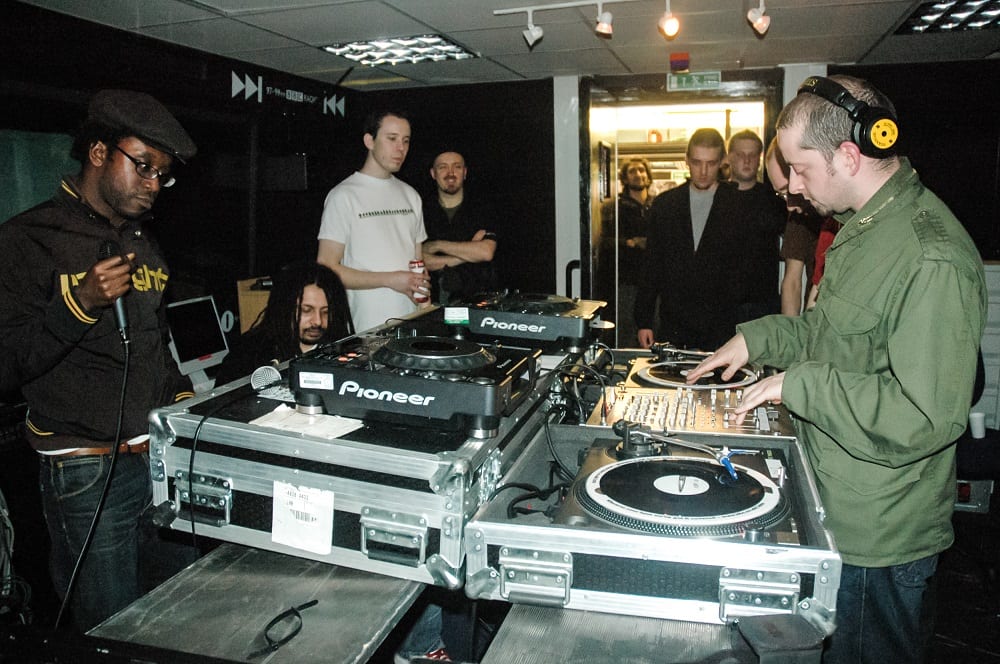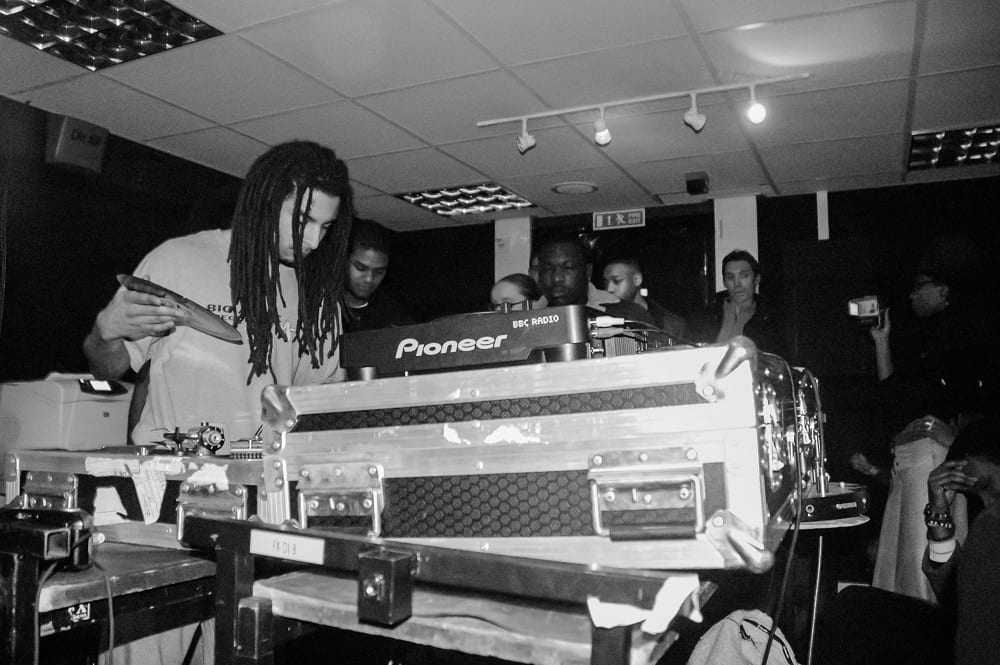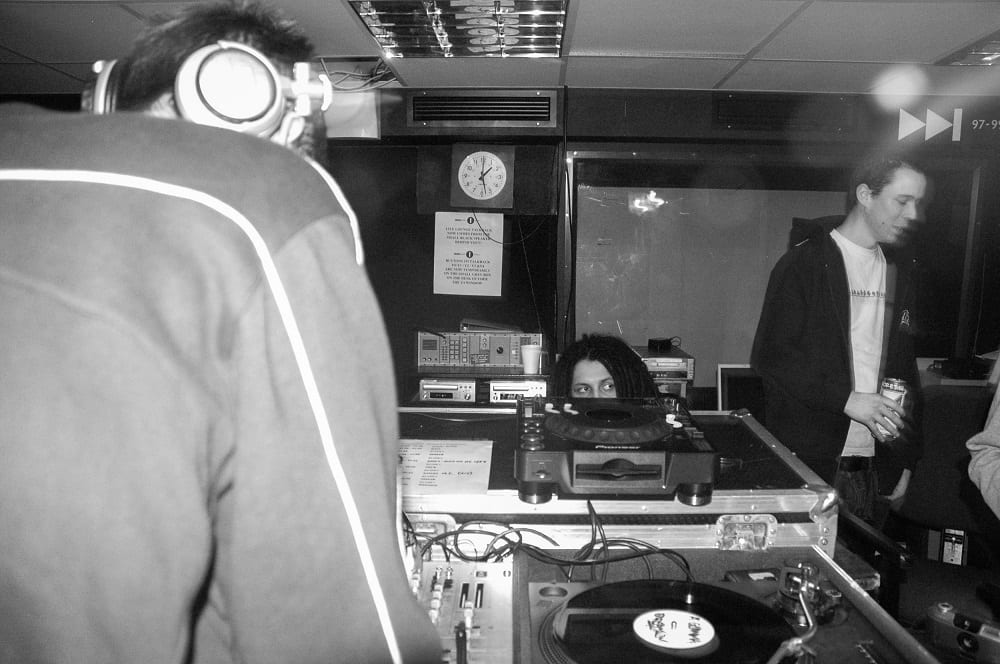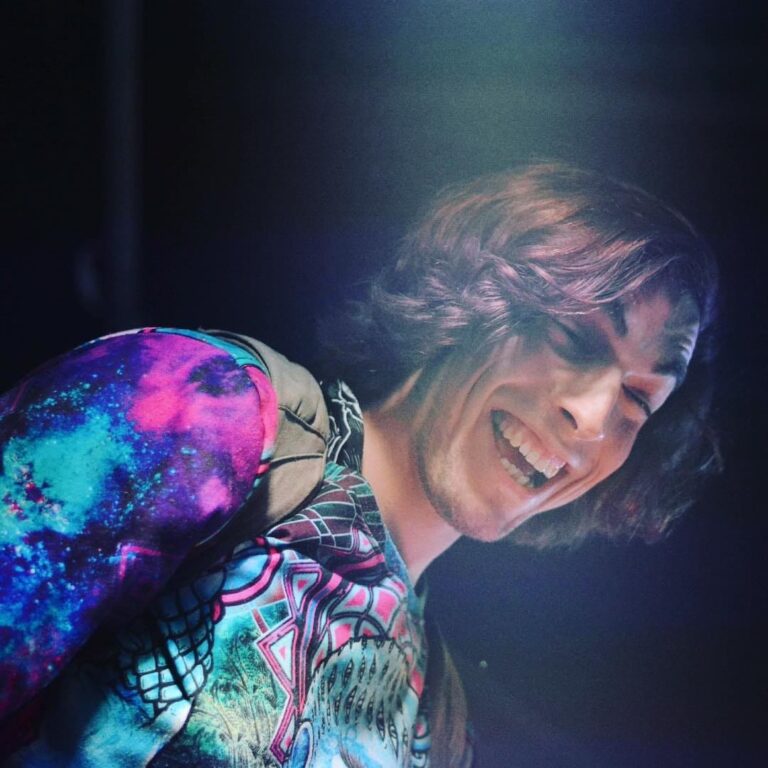The meteoric rise of dubstep saw it evolve almost overnight from the most exciting scene in the British underground to a myriad of urban sound that permeated every corner of the planet. Birthed in South London around the turn of the millennium, it found a home in the back rooms of Croydon’s record shops, the dingiest basement venues and the secret locations of the capital’s pirate radio stations. Taking influence from a host of genres such as garage, jungle and Britain’s history with dub, reggae and sound system culture, the raw sound attracted some of the most talented yet sonically homeless artists, who together injected fresh and innovative ideas into the UK’s club land.
You can’t start a fire without a spark. Dubstep’s catalyst saw Mary Anne Hobbs, the BBC Radio 1 DJ who presented the experimental Breezeblock show, bring together a group of South London’s finest to showcase the rich diversity of the genre. The show introduced to the world the likes of Mala, Skream, Kode9, Vex’d, Hatcha, Loefah and Distance, alongside MCs The Space Ape, Sgt Pokes and Crazy D, who came together on a fateful January night to mark the beginning of a dubstep revolution. Fifteen years on from that seminal moment, we spoke with some of the pioneers who were there for one of the most iconic slices of modern musical history…
“It’s about the atmosphere the beat can create, it can open your mind to where the sound can take you.” – Digital Mystikz (2006)
As the chest-rattling sounds of D1’s later named Dubstep Warz track beamed out, accompanied by vocal introductory cuts from some of the scene’s fledgeling global players, the show immersed the listener in a wall of sound, encouraging them to journey down a rabbit hole of sonic discovery. Oliver Jones aka Skream was the youngest artist to play on the night.
“On the night, no one knew how big and important the show would be,” he tells us. “For us in the studio, it was just a laugh and a bit of a day out. When the intro of the show started and you heard people from all around the world like Bruno Belluomini and Joe Nice, it felt epic.”
This feeling of uncertainty surrounding the potential of the show was shared by others who were in the studio. One half of Digital Mystikz alongside Mala, Coki did not play on the night, but was in attendance. “Going up to Radio 1 was a bit of a wow moment,” he recalls. “With the night itself, it’s hard to explain, because it was just mixed emotions because we didn’t know where we were going from there, like when it finished, we’d just go back to what we normally do.”
“I’m not making it for people in their bedrooms…I’m making it to be played on as big a sound system as you can get your hands on.” – Kode9 (2006)
Dubstep’s early success was built on the passion and unrestricted dedication of a small group of artists who were represented by those who performed on the night. “I don’t think anyone realised what was going to happen with the show, we were just like we’ve been taken up to the radio to play our music for fifteen minutes,” DJ Distance explains. “I don’t think we realised the impact at the time, because we were so focused on making music and that was all we cared about!”
Distance, who closed the proceedings on the night, was turned onto the sound after experiencing it first-hand at FWD>> like many of his contemporaries. As they were genre visionaries, the artists had nothing to aspire to, both sonically and in terms of the reach of the music. “It was so free back then,” he continues. “All we basically wanted was to make something that sounded ridiculous on the sound system that was in FWD>>.”
If FWD>> was the testing ground, then South London was the foundation. Roly Porter was one half of Vex’d; a sonically devilish duo who won the Breezeblock mix for 2005 with their dynamic and explosive bass distortions. Reflective and thoughtful, he recounts living in South London at the time.
“London was a completely different environment to what it is now. You could live a lot cheaper and it just felt a lot less polished. There was a different feel in the city, not just in the clubbing scene.”
Although not a part of the Dubstep Warz show, Caspa’s impact in developing, solidifying and showing the heights that the genre could reach is undisputable. He ventures that the dubstep genre’s success was representative of the culture it grew up around. “It was fresh and exciting, and it didn’t conform to what was happening.” It was the most unique mix of people; it was a melting pot of cultures. It created such a unique scene- it WAS London.”
“The whole dubstep scene is like family. Everyone wants to work together and collaborate, so it makes sense we live not too far from each other. At the same time, the whole London thing is becoming less relevant as the music becomes worldwide.” – Vex’d (2006)
The early scene’s stomping grounds were unrecognisable to the behemoth venues that support the genre following the global expansion at the end of the noughties, however. Roly recalls the scene in its formative years.
“There was a night on Brixton Hill and when I first went there were like five people in there and no one was dancing, there was no lighting, just deafening bass. There were no social aspects, it was just about the bass, which made it all so exciting.”
Distance agrees, laughing when he describes the early dubstep canvas. “We just wanted to get away with as much space as possible in our tune. All we wanted was the reaction of dropping it in a club and feeling your guts vibrating!” From these humble beginnings, Dubstep Warz offered the artists the chance to showcase their bass-orientated beats to the world.

What made the show so unique was the variety in terms of influences the artists drew their sound palettes from. Dubstep’s rise and move towards the more recognisable half-time beat and wobble bassline is almost unrecognisable in the cacophony of sound showcased on the night. “At the time, the beats were still very garagey, a lot more stripped back than they are now,” Skream explains. “There were drums, bass and some samples, and that was it really!” On the night, Hatcha’s introduction tells how every producer is different so you can’t pinpoint the sound, but the whole community grew under the name ‘dubstep.’ “The show was a great representative of the sound,” Skream continues. “Everyone had their own style, but then they all came together under one umbrella.”
“The music we were playing at the FWD>> nights didn’t really have a name; it had a lot of sounds from all different types of music in it… We just called the whole community of music dubstep, and that’s what it’s grown as, so let it be.” – Hatcha (2006)
Like Skream, Distance speaks fondly of the diversity in the early sound. “It’s why the period was such a magical time, because even though we had our influences and were listening to different things, we were connected by this underground dance scene. It was a melting point of garage, breakbeat, drum and bass and dub, but the scene was the only connecting point between us. It’s why the Mary Anne Hobbs show is so epic even now, because you’ve got all of us who came from different angles, while now there is a reference for new artists as so much has been done before.”
Roly Porter agrees, stating that the variety was “one of the most exciting aspects listening back to that show. That variety has now been kind of lost as parts have embedded themselves in different scenes around the world.” From Digital Mystikz’s dub-infused weight, to Skream’s darker garage-influenced flavours, from Distance’s nu-metal moodiness, to Loefah’s beautifully tooled system-destroyers, the multifarious nature of the show is why it inspired so many to gravitate towards 140 bpm culture. Roly summed up the atmosphere on the night. “I just remember feeling the genuine excitement about not knowing what kind of music we were going to hear next. It was a while since I had felt that kind of enthusiasm about something!”
“There was a band that came about, and for me, they were the most interesting band. They were called Korn and they had this midi-pad on their drum kit, and it was a pure sub every time they hit it. From then, I liked this idea of electronic music making with a heavy bass sound. – Distance (2006)
The most important factor of the success of Dubstep Warz, however, was the support from Mary Anne Hobbs herself. Like the late John Peel before her, who was an early supporter of the genre, she recognised the energy and potential dubstep held as it prepared to explode on a global scale. It’s unsurprising how those involved hold her in the highest esteem. Roly Porter muses how difficult it would have been to support a fledgling scene like dubstep on a station like Radio 1.
“It’s interesting when you think about how you support a burgeoning scene with a new sound and push it to the masses, without immediately dilating it and over-exposing it,” he says. “I think her approach was perfect as it ensured our music maintained its integrity. She never put any pressure on us about what to play, we could have submitted anything, and she would have supported it!”
DJ Distance echoes this statement. “The fact that she gave the sound a chance was just amazing- we weren’t given any guidelines or instructions, other than you come and play whatever you want. It was really respectful and trusting of her to let us represent what we did, completely uncensored.”

So, what impact did the show really have on the development of the genre? The most important factor is the timing of the show. 2006 was a time of constant change in the music industry, as in it began to move towards the complete digitalisation of the finished product. The internet phenomenon was taking hold of the world, and the reach of the music was beginning to recognise its potential.
“I remember in the old days, you’d go to a club and you’d hear a tune that would only be played in that small part of the world,” Roly Porter says. Skream also agrees that with the accessibility of content now, the show’s impact would have been lost if it first broadcasted in 2021. “It’s so easy to get your hands on everything nowadays. The fact it went out on a major broadcast meant that it would have been heard by some countries that might not have heard it before.”
“At our dance, no one’s watching each other. They’re just there in their own space having a good time. It’s not moody at all, but it’s not like an old rave where everyone’s trying to hug you and be your friend. People don’t really go out to a dubstep night to check girls, it’s not really a big drug music either so there aren’t lots of drug dealers. We don’t really have MC’s so there aren’t any ego clashes in there, it’s just purely sound.” – Loefah (2006)
Following the Dubstep Warz show, the genre saw an uplift in support as more people were turned towards the unpredictable beats. Dubstep, especially in the capital, grew at an unprecedented rate, capturing the imagination of a new generation and introducing them to the sound. DMZ (De-Militarized Zone) was an influential label and club night operated by Mala, Coki and Loefah. Just months after the show, their regular night at Brixton’s Third Base felt the full effect of the growth.
“We noticed the parties began to double and even triple in size,” Coki tells us. “There was one night when we had to move upstairs to Mass and its big room because there were so many people queuing to get in!” The night in question was March’s session when the club was full by 10pm. Dubstep’s success was seeing it outgrow its roots as it prepared to fully take the world by storm. “It was totally ridiculous, just because Dubstep Warz had been on the radio. People were like ‘what is this, we need to go and check out dubstep and find out what it’s all about,’”
These developments weren’t just limited to the underground, however. Before long, the dubstep sound began to embed itself into mainstream British culture. In 2007, the iconic, coming-of-age series Skins was the first programme to feature dubstep on television, when they included Skream’s ‘Angry’ and ‘Colourful.’ “I was watching Skins at the time and nobody told me the tunes were going to be on it,” Skream recalls. “I was actually quite impressed, as they dug quite deep for the tracks, as Angry was on a B-side!”
“A lot of that grime sound is MC-driven, so if the MC’s say it’s a big tune, then it’s a big tune. Since then, they’ve acknowledged dubstep. Midnight Request Line can help the scene, bridging the gap.” – Skream (2006)
The most defining moment for the genre, however, was when it reached America and fell in with the rise of the EDM movement that swept from East to West coast. A regular tourer of the States, Distance explains the importance of the American scene.
“The Americans do everything so much bigger, so it really got the mainstream attention and mass appeal. All the stadium arenas were for rock bands, and all of a sudden, you had them full of dubstep DJs,” says Caspa who moved out to Denver to immerse himself into the American movement. “In certain places like New York, Los Angeles and Denver, they got the importance of soundsystem culture.”
He explains how once this importance was grasped by fans and promoters, the sound really took off. “Once the clubs were set up to provide (the sound), the demand grew, and dubstep became a phenomenon across America. Now, I feel the US and Canada have been as much an influence on the UK and Europe as we were on them in the early days. Like it or not, we shouldn’t deny that!”
For an artist like Skream, this expansion of the genre to the scale it reached in America was the end goal of what he had been trying to achieve since he began. “I was always trying to push it to as many people as possible! Me and Benga wanted it to be massive, we wanted to go and do big shows and not just stay in basements. When it got taken out of our hands and changes started being made it rubbed a few people up the wrong way as our influence over the sound had gone, so there will always be that old vs new school battle, but for me, I like seeing things progress.”
And although we have seen the sound and culture surrounding dubstep continue to grow and progress, the legacy of the Dubstep Warz show is still being felt to this day. Sicaria Sound are a duo who, since emerging out of university, have pushed their futuristic fusion of experimental hybrids out to new generations of bass fans, establishing themselves as two of the finest purveyors of underground sonics. The Deep Medi residents (a label owned by Dubstep Warz veteran Mala) were too young to hear the show when it first aired but highlight how influential it was for them when they became involved in the scene.
“Your love for it comes from the moment you find it. In the case of shows like this, you can listen back to them at any point and always feel that same energy. A lot of the generation currently making dubstep were influenced by the show and the artists in it. These modern-day producers make music derived from the blueprint but with their own flair. The legacy of the originators is always there and respected, whilst people are also unafraid to carve their own path!” Like those who were there on the night, their admiration for what Mary Anne Hobbs managed to achieve with the show is clear. “Her energy and enthusiasm in presenting on the genre was infectious and seminal, especially at a time when people weren’t giving dubstep a national platform. She helped pave the way for something incredible to happen!”
Dubstep Warz still sounds as vital, as primal and as thrilling as the night we threw it down… it brings tears to my eyes. If, as a broadcaster, you can deliver one show with the cultural and historical impact of this one in a lifetime…it’s a miracle.” – Mary Anne Hobbs (2011)
Dubstep may have eventually reached the grandeur it now demands without the show, but through the work of a small group of artists, a blueprint was set for where the sound could go. Through helping expose the masses to something new, exciting and at the time, still completely underground, Dubstep Warz can only be considered a hugely influential and culturally significant moment in dance music history.
Watch: Dubstep Warz Behind The Scenes on Hyperdub



